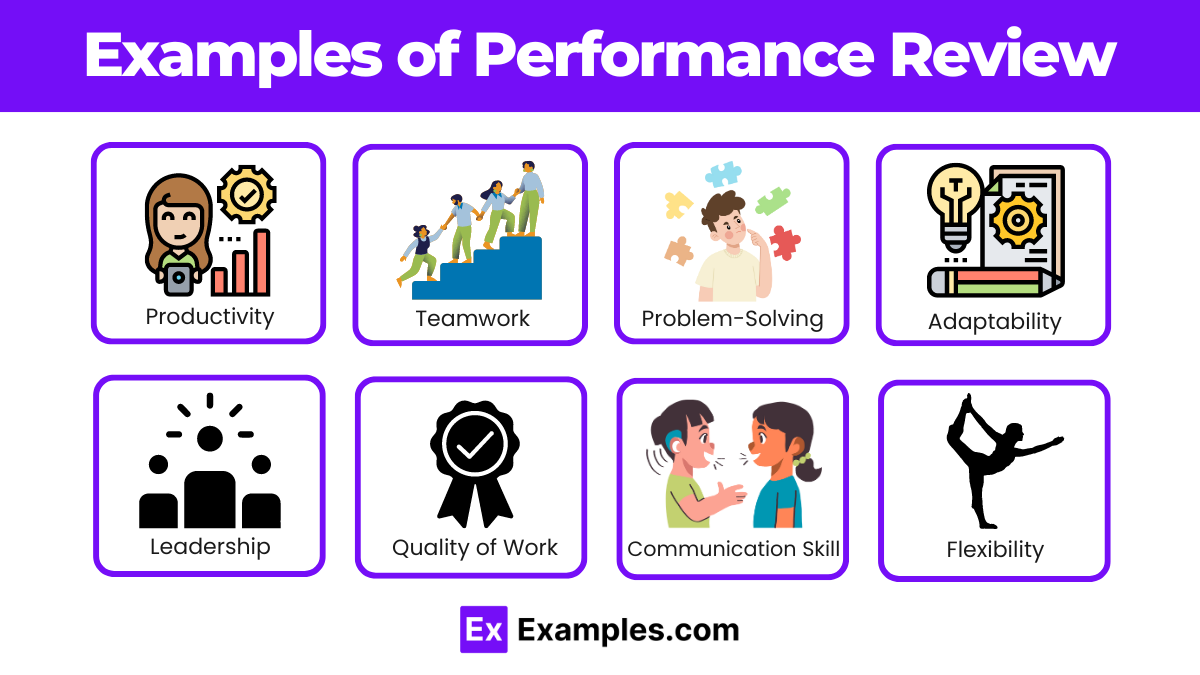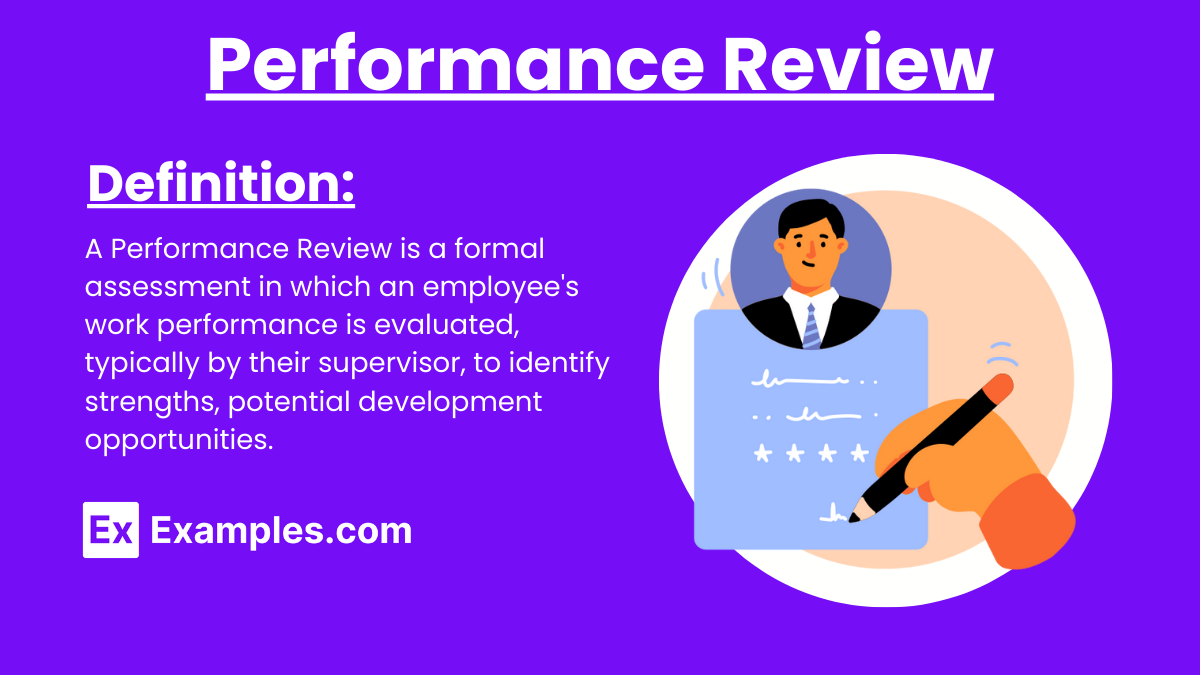25+ Performance Review Examples to Download
A Performance Review is a crucial process in evaluating an employee’s work performance over a specific period. During an Employee Performance Review, both the employer and employee discuss the strengths, weaknesses, and areas for improvement. The Review Agenda typically includes a discussion of goals, achievements, and any challenges faced. Effective Performance Review Comments provide valuable feedback, fostering growth and development within the organization.
What is Performance Review?
A Performance Review is a formal assessment in which an employer evaluates an employee’s work performance, typically involving feedback on strengths, weaknesses, and areas for improvement. This process aims to enhance employee development and align their goals with organizational objectives.
Examples of Performance Review

1. Productivity
- Exceeds expectations in completing tasks efficiently and accurately.
- Consistently meets deadlines and often finishes projects ahead of schedule.
- Shows a strong work ethic and dedication to producing high-quality work.
- Regularly goes above and beyond in their responsibilities.
- Needs to improve in managing time effectively to meet deadlines.
2. Communication Skills
- Demonstrates excellent verbal and written communication skills.
- Communicates effectively with team members and management.
- Actively listens and provides constructive feedback.
- Could improve clarity and conciseness in emails and reports.
- Needs to engage more in team discussions and meetings.
3. Teamwork
- Is a strong team player and often assists colleagues without being asked.
- Collaborates well with others and contributes to a positive team environment.
- Demonstrates leadership skills in team projects.
- Sometimes struggles to work effectively within a team.
- Could improve by being more open to different perspectives and ideas.
4. Problem-Solving
- Shows exceptional problem-solving skills and can think quickly on their feet.
- Consistently identifies innovative solutions to complex issues.
- Approaches problems with a positive attitude and a willingness to find solutions.
- Needs to develop better strategies for addressing recurring issues.
- Could improve by seeking input from others when solving problems.
5. Adaptability
- Easily adapts to new situations and challenges.
- Shows flexibility in taking on new roles and responsibilities.
- Handles changes and unexpected obstacles with composure.
- Struggles with adapting to sudden changes in priorities.
- Needs to be more open to trying new approaches and techniques.
6. Leadership
- Exhibits strong leadership qualities and motivates team members.
- Leads by example and fosters a culture of respect and collaboration.
- Takes initiative in driving projects forward.
- Needs to work on developing stronger leadership skills.
- Could improve by providing more guidance and support to team members.
Performance Review Examples for Managers
Example 1: Exceptional Leadership and Team Development
Manager Name: Laura Martinez
Position: Sales Manager
Review Period: January 2023 – June 2023
Laura has demonstrated exceptional leadership skills and a strong commitment to team development over the past six months. Her ability to inspire and motivate her team has resulted in outstanding sales performance. Laura’s strategic planning and goal-setting have been instrumental in achieving department targets. She actively supports her team members’ professional growth, providing constructive feedback and opportunities for advancement.
Example 2: Effective Project Management and Communication
Manager Name: David Nguyen
Position: Project Manager
Review Period: January 2023 – June 2023
David has excelled in managing multiple complex projects, ensuring they are completed on time and within budget. His effective communication skills have been crucial in maintaining transparency and alignment among stakeholders. David’s attention to detail and proactive problem-solving approach have minimized risks and enhanced project outcomes. He has successfully led his team through challenging situations, maintaining high morale and productivity.
Performance Review Phrases
1. Dependability and Reliability
- “Consistently meets deadlines and manages time effectively.”
- “Is always punctual and rarely misses work.”
2. Communication Skills
- “Communicates ideas clearly and effectively.”
- “Listens actively and responds appropriately.”
3. Teamwork and Collaboration
- “Works well with others and contributes to a positive team environment.”
- “Is cooperative and helpful to colleagues.”
4. Initiative and Motivation
- “Takes initiative to start new projects and improve processes.”
- “Is highly motivated and shows a strong work ethic.”
5. Problem-Solving Skills
- “Identifies problems quickly and develops effective solutions.”
- “Thinks critically and approaches challenges with a positive attitude.”
6. Quality of Work
- “Produces high-quality work consistently.”
- “Pays attention to detail and takes pride in work.”
7. Adaptability and Flexibility
- “Adapts well to new situations and changes in the workplace.”
- “Is flexible and open to new ideas and approaches.”
How to give Positive Performance Review
Prepare Thoroughly: Gather Information – Collect data on the employee’s performance, achievements, and feedback from colleagues. Review Goals – Assess progress toward previously set goals. Plan the Discussion – Outline key points and examples to discuss.
Create a Comfortable Environment: Private Setting – Ensure the review takes place in a private, comfortable setting. Positive Tone – Start with a friendly and positive tone to set the stage for a constructive discussion.
Start with Strengths and Achievements: Highlight Accomplishments – Begin by acknowledging the employee’s significant achievements and contributions. Specific Examples – Use specific examples to illustrate the employee’s strengths and successes.
Provide Constructive Feedback: Balanced Feedback – Offer a mix of positive feedback and constructive criticism. Improvement Areas – Identify areas where the employee can improve, providing actionable suggestions.
Set Clear and Achievable Goals: SMART Goals – Set Specific, Measurable, Achievable, Relevant, and Time-bound goals. Collaborative Goal Setting – Involve the employee in setting goals to ensure buy-in and commitment.
Discuss Development Opportunities: Training and Development – Identify opportunities for further training and development. Career Growth – Discuss potential career advancement and pathways within the organization.
Encourage Open Communication: Active Listening – Encourage the employee to share their thoughts, concerns, and aspirations. Two-Way Dialogue – Foster a two-way conversation to ensure the employee feels heard and valued.
Why it’s Important to get Performance Review
Feedback and Improvement: Performance reviews offer employees structured feedback on their work. This feedback highlights strengths and identifies areas for improvement, providing a clear path for professional growth.
Goal Setting and Career Development: Through performance reviews, employees and managers can collaboratively set realistic and achievable goals.
Recognition and Motivation: Receiving positive feedback and recognition for achievements boosts employee morale. Acknowledging hard work and accomplishments reinforces positive behaviors and motivates employees to maintain or improve their performance.
Clarification of Expectations: Performance reviews clarify job roles and expectations. They ensure that employees understand what is expected of them and how their work contributes to the organization’s success.
Employee Development: Performance reviews identify training and development needs. Managers can recommend specific training programs or resources to help employees enhance their skills.
How to use our Different Performance Review
- valuate Initial Performance: Assess how well the new employee has adapted to the role and met initial expectations.
- Provide Feedback: Offer constructive feedback to help the employee improve and grow.
- Make Employment Decisions: Decide whether to confirm the employee’s appointment, extend the probation, or terminate the employment.
- Set Future Goals: Establish clear goals and expectations for the next phase of their employment.
Performance Reviews for employees
Goal Setting: Performance reviews help set clear, achievable goals. Employees understand what is expected of them and can align their efforts with organizational objectives.
Feedback: Regular feedback helps employees understand their strengths and weaknesses. Constructive criticism can guide them toward improvement, while positive feedback reinforces good performance.
Development: Performance reviews identify training and development needs. Employees can take advantage of opportunities to enhance their skills and advance their careers.
Motivation: Recognizing and rewarding good performance motivates employees. It boosts morale and encourages them to maintain or improve their performance.
Communication: Reviews foster open communication between managers and employees. They provide a platform for discussing concerns, expectations, and career aspirations.
Performance Reviews for Teams
Regular Reviews: Conduct performance reviews regularly, not just annually. Frequent check-ins help address issues promptly and keep the team on track.
Continuous Feedback: Provide ongoing feedback throughout the year. This makes the formal review process smoother and more effective.
Training for Managers: Train managers on how to conduct effective team performance reviews. Skilled managers can provide more meaningful and constructive feedback.
Team Involvement: Involve all team members in the review process. Encourage them to share their perspectives and participate in goal setting.
Follow-Up: Regularly follow up on the goals and development plans set during the review. Ensure progress is being made and provide support as needed.
Performance Reviews for Leaders
Leadership Development: Reviews identify areas for growth and development, enabling leaders to enhance their skills and capabilities.
Accountability: Performance reviews hold leaders accountable for their actions and decisions, ensuring they meet organizational standards and goals.
Alignment with Goals: Reviews ensure that leaders’ objectives align with the broader goals of the organization, fostering coherence and strategic direction.
Feedback Loop: Constructive feedback helps leaders understand their strengths and areas needing improvement, promoting continuous learning.
Employee Morale: Effective leadership reviews can positively impact team morale, as leaders become more adept at managing and motivating their teams.
Monthly and Quarterly Performance Reviews
1. Continuous Improvement: Regular reviews promote continuous improvement by providing frequent feedback and opportunities for adjustments.
2. Goal Alignment: They ensure that short-term goals are aligned with long-term objectives, keeping everyone focused and on track.
3. Early Issue Identification: Frequent reviews help identify and address performance issues early, preventing them from escalating.
4. Enhanced Communication: Regular check-ins foster open communication between employees and managers, building stronger working relationships.
5. Motivation and Engagement: Consistent feedback and recognition boost employee morale and engagement, encouraging sustained high performance.
Annual and Semiannual performance reviews
Preparation: Both managers and employees should prepare for the review. Managers should gather performance data, while employees should reflect on their achievements and challenges.
Objective Assessment: Use measurable criteria to assess performance. Focus on specific goals, metrics, and examples to provide a clear and objective evaluation.
Constructive Feedback: Provide balanced feedback, highlighting strengths and areas needing improvement. Offer actionable suggestions for enhancement.
Goal Setting: Set or review SMART (Specific, Measurable, Achievable, Relevant, Time-bound) goals. Ensure goals are relevant to both individual and organizational objectives.
Development Plans: Create or update development plans that include training, mentorship, or other resources to help employees grow.
Documentation: Keep detailed records of the review. Documenting discussions and agreements ensures accountability and provides a reference for future reviews.
What is the purpose of a performance review?
The purpose is to assess job performance, set goals, and provide feedback, much like a movie review outline helps critique and improve films.
What should be included in a performance review?
Include objective assessments, feedback, goal setting, and development plans, akin to an employee review for comprehensive evaluation.
How can employees prepare for a performance review?
Employees should reflect on their achievements and challenges, similar to preparing a self review or article review.
What is a self-review in performance evaluations?
A self-review allows employees to assess their own performance, providing insight similar to an article review by the author.
How does feedback work in a performance review?
Feedback includes both positive and constructive comments, like the balanced critique found in a movie review outline.
What is the role of goal setting in performance reviews?
Goal setting aligns employee objectives with company goals, similar to outlining the main points in an article review.
How can performance reviews improve employee performance?
Reviews provide clear feedback and development plans, enhancing performance as an employee review refines job roles.
What is the difference between annual and semiannual reviews?
Annual reviews cover a year, while semiannual reviews occur every six months, offering more frequent feedback like periodic self reviews.
How should performance review feedback be delivered?
Feedback should be clear, constructive, and supportive, much like the detailed critique in a well-rounded employee review.
What are the benefits of self-reviews for employees?
Self-reviews encourage self-reflection and accountability, enhancing performance like the introspection in an article review.


